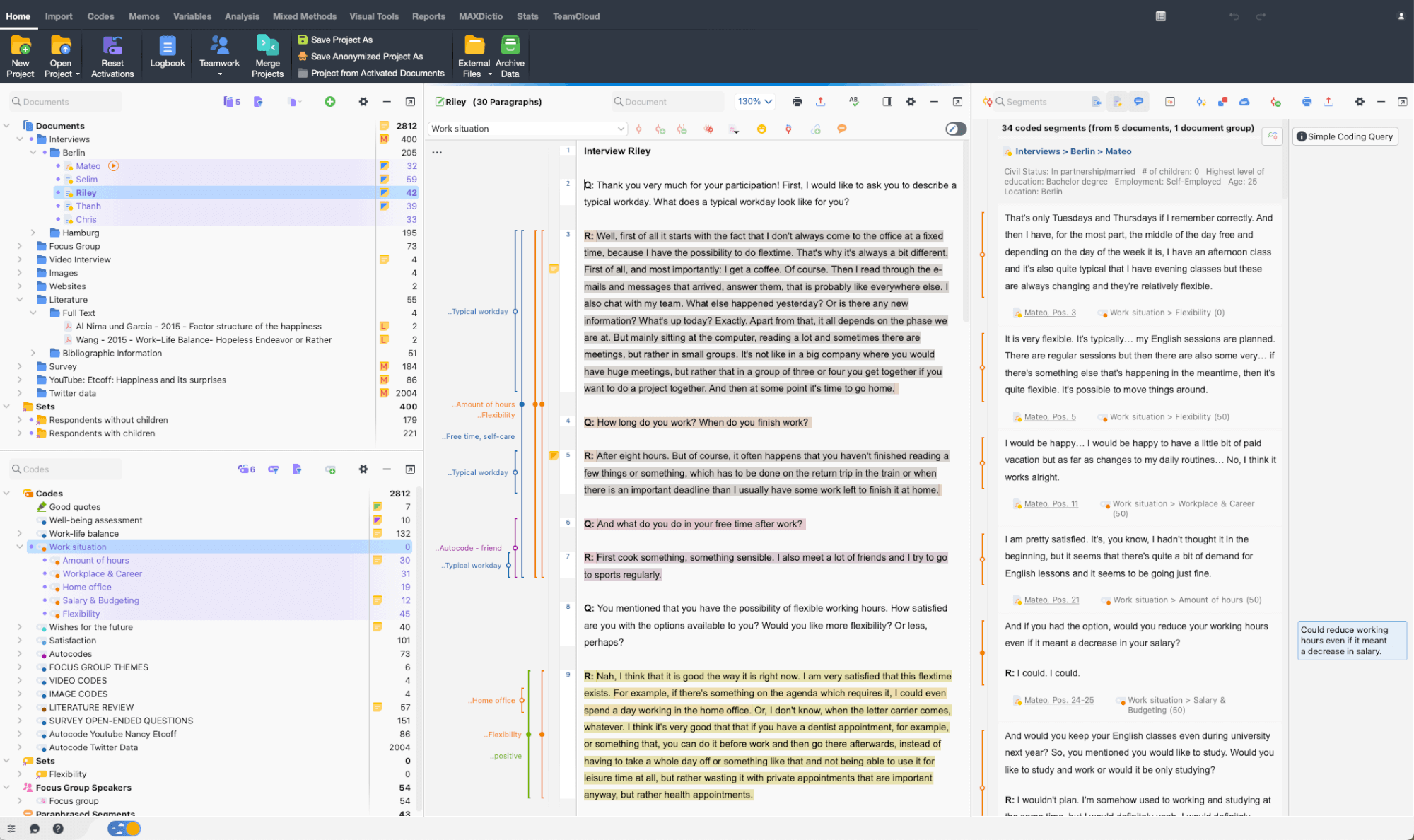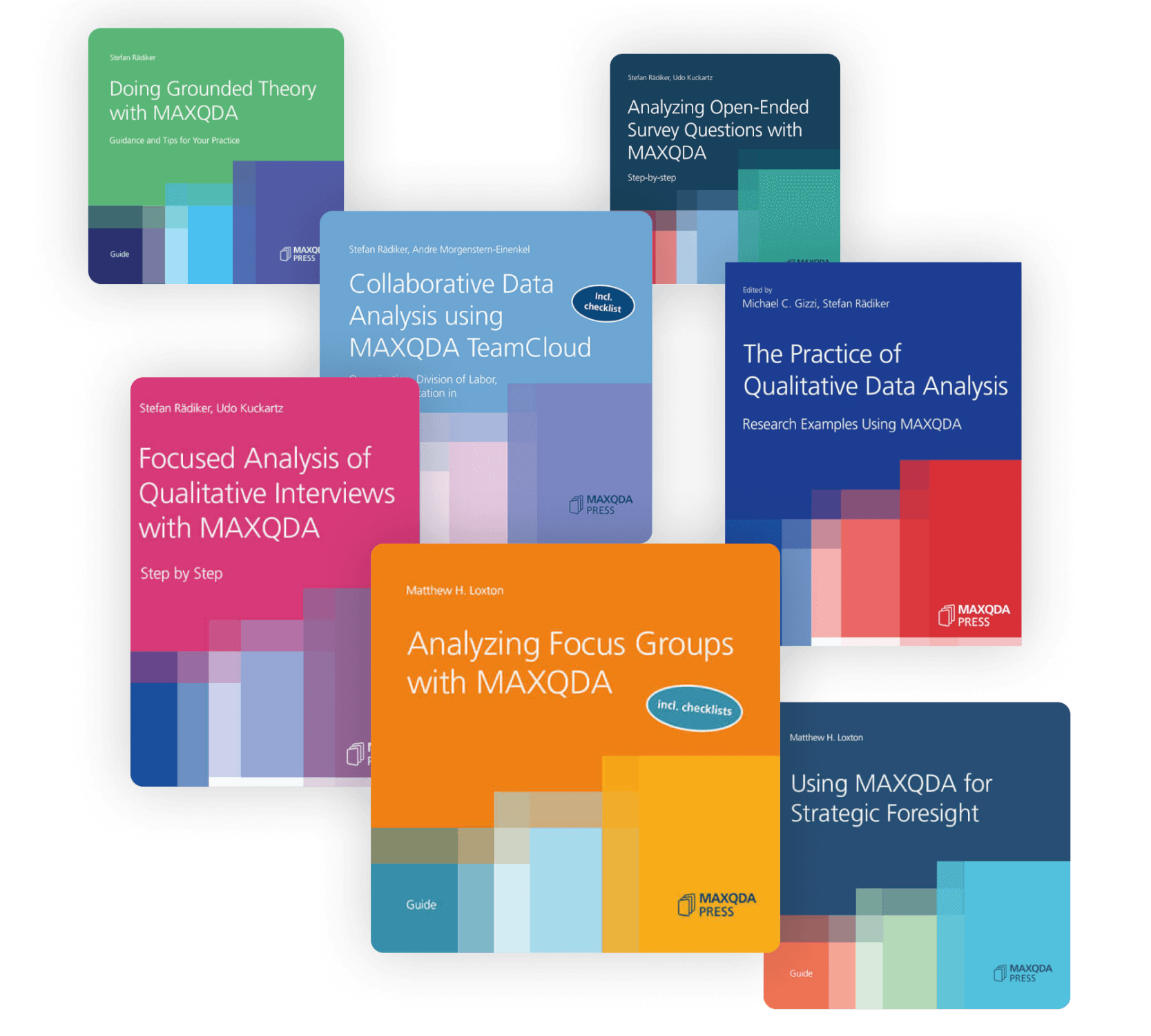The #1 Mixed Methods software with the best AI integration
MAXQDA streamlines your Mixed Methods research with powerful analysis tools, ease of use, and smart AI integration. Explore the possibilities now.
Take your mixed methods research to the next level with MAXQDA
MAXQDA is the best choice for your mixed methods analysis. It works with a wide range of data types and offers powerful tools for focus group data analysis, such as coding, visualization, mixed methods, statistical, and quantitative content analysis tools.
Your data
Your codes
Document viewer
Your analysis

AI-Powered Mixed Methods Analysis Software for Windows and Mac
For mixed methods research, MAXQDA is a premier choice, enriched with state-of-the-art AI-powered tools. These features optimize your workflow by seamlessly integrating qualitative and quantitative data, providing automatic coding suggestions, pattern detection, and AI-driven insights. With MAXQDA, you can analyze smarter and faster, bridging the gap between methodologies to uncover comprehensive and meaningful results with ease and precision.
Developed by and for researchers – since 1989








Having used several qualitative data analysis software programs, there is no doubt in my mind that MAXQDA has advantages over all the others. In addition to its remarkable analytical features for harnessing data, MAXQDA’s stellar customer service, online tutorials, and global learning community make it a user friendly and top-notch product.
Sally S. Cohen – NYU Rory Meyers College of Nursing
Mixed Methods is Faster and Smarter with MAXQDA
Analyze all kinds of data – from texts to images and audio/video files, websites, tweets, focus group discussions, survey responses, and much more. MAXQDA is at once powerful and easy-to-use, innovative and user-friendly, as well as the only leading QDA software that is 100% identical on Windows and Mac.
All-in-one Mixed Methods Software
As your all-in-one Mixed Methods Software, MAXQDA can be used to manage your entire research project. Easily import a wide range of data types such as text documents, interview transcripts, focus groups, online surveys, web pages, images, audio and video files, spreadsheets, bibliographic data, YouTube data, and even tweets. Easily add demographic or other variables to create and compare groups of interest. Organize your data in groups, link relevant quotes to each other, and share and compare work with your team members. Your project file stays flexible and you can expand and refine your category system as you go to suit your research.


Include quantitative data to enhance your research
MAXQDA is the mixed methods expert! With MAXQDA as your mixed methods software, you can easily combine qualitative and quantitative methods to get an even deeper insight into your data. MAXQDA offers numerous tools and functions that you can use to enhance your mixed methods analysis. MAXQDA Standard offers an entire tab dedicated to mixed methods research with tools designed to facilitate mixed methods research; MAXDictio, the add-on module of MAXQDA Plus, includes many quantitative text analysis tools that allow you to explore the content and structure of your texts; and MAXQDA Stats offers an entire module dedicated to statistical analysis.
Quantitizing of qualitative coding information
Researchers all around the world enrich their qualitative data analysis with quantitative data. As your all-in-one Mixed Methods Software, MAXQDA allows you to import and explore quantitative data as well. Easily import quantitative data matrices from statistics software packages like SPSS or Excel spreadsheets and explore them with MAXQDA’s mixed methods tools. You can also turn your codes into variables to perform statistical analyses, and automatically or manually assign variables to your data. Of course, you can also export your data matrices from MAXQDA to statistics software packages like SPSS.


Create and compare groups
Researchers all around the world use MAXQDA as their mixed methods software because with MAXQDA you have many possibilities to create and compare groups of documents. For example, you can group interviewees based on variables or code frequencies. With MAXQDA as your mixed methods software, you can easily compare the code frequencies of various groups with each other or identify and quantify similarity or dissimilarity in code frequency across your data. Calculate various variables and their percentages for qualitative typologies. Especially useful for mixed methods research are MAXQDA’s joint displays that visualize integrated data and/or results.
Aggregate your data
A Mixed Methods research project can be overwhelming, but with MAXQDA as your mixed-methods software, you have an easy-to-use solution. Among other tools, MAXQDA’s overview and summary tables are especially useful for aggregating your content analysis results. MAXQDA offers overview tables for almost everything, codes, memos, coded segments, links, and so on. Use our summary grids and summary tables to keep summaries of which codes and variables appear in each respective project or document: another level of analysis that means you’ll never lose track of the bigger picture. Of course, you can easily export your overview and summary tables and integrate them into your publication.


Quantitative evaluation of themes
Quantitative aspects can also be relevant in a qualitative research project. Using MAXQDA as your state-of-the-art Mixed Methods Software enables you to employ a vast range of procedures for the quantitative evaluation of your material. You can sort sources according to document variables, compare amounts with frequency tables and charts, and much more. Make sure that you don’t miss the word frequency tools of MAXQDA’s add-on module for quantitative content analysis. Included are tools for visual text exploration, content analysis, vocabulary analysis, dictionary-based analysis, and more that facilitate the quantitative analysis of terms and their semantic contexts.
Visualize qualitative and quantitative data
As an all-in-one Mixed Methods Software, MAXQDA offers a variety of visual tools that are tailor-made for analyzing qualitative data as well as quantitative data. Create stunning visualizations to analyze your material. Of course, you can export your visualizations in various formats to enrich your final report. Visualize the progression of an interview with the Codeline, use the Code Cloud to illustrate and explore your categories, or make use of the graphical representation possibilities of MAXMaps, which in particular permit the creation of concept maps. Thanks to the interactive connection between your visualizations with your MAXQDA data, you’ll never lose sight of the big picture.


AI Assist: Mixed Methods meets AI
AI Assist – your virtual research assistant – supports your Mixed Methods Analysis with various tools. Besides automatic transcription of audio and video recordings in different languages, AI Assist simplifies your work by automatically analyzing and summarizing elements of your research project and by generating suggestions for subcodes. No matter which AI tool you use – you can customize your results to suit your needs.
Free tutorials and guides on Mixed Methods analysis
MAXQDA offers a variety of free learning resources for Mixed Methods analysis, making it easy for both beginners and advanced users to learn how to use the software. From free video tutorials and webinars to step-by-step guides and sample projects, these resources provide a wealth of information to help you understand the features and functionality of MAXQDA for Mixed Methods analysis. For beginners, the software’s user-friendly interface and comprehensive help center make it easy to get started with your data analysis, while advanced users will appreciate the detailed guides and tutorials that cover more complex features and techniques. Whether you’re just starting out or are an experienced researcher, MAXQDA’s free learning resources will help you get the most out of your Mixed Methods analysis.


